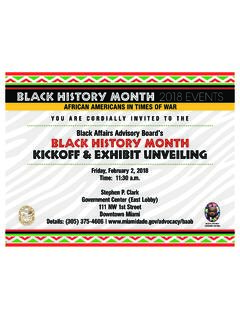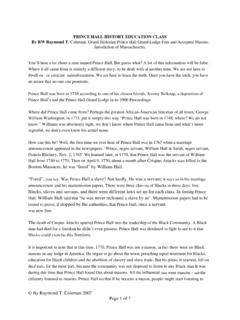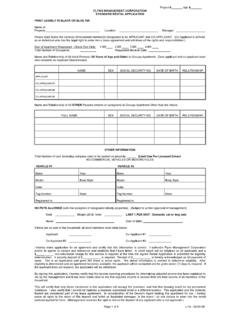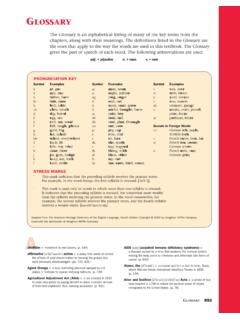Transcription of A Brief History - Navajo Nation
1 The The Navajo Navajo : A. A Brief History : Brief History According to scientists who study different cultures, the first Navajo lived in western Canada some one thousand years ago. They belonged to an American Indian group called the Athapaskans and they called themselves "Dine" or "The People". As time passed, many of the Athapaskans migrated southward and some settled along the Pacific Ocean. They still live there today and belong to the Northwest Coast Indian tribes. A number of Athapaskan bands, including the first Navajos, migrated southwards across the plains and through the mountains. It was a long, slow trip, but the bands weren't in a hurry. When they found a good place to stay, they would often live there for a long period of time and then move on.
2 For hundreds of years, the early Athapaskan bands followed the herds of wandering animals and searched for good gathering grounds. Scientists, believe that some Athapaskan bands first came to the American Southwest around the year 1300. Some settled in southern Arizona and New Mexico and became the different Apache tribes. Apache languages sound very much like Navajo . The Navajo Athapaskans settled among the mesas, canyons, and rivers of northern New Mexico. The first Navajo land was called Dine'tah. Three rivers - the San Juan, the Gobernador, and the Largo ran through Dine'tah, which was situated just east of Farmington, New Mexico. By the year 1400, the Navajos came in touch with Pueblo Indians. The Navajos learned farming from the Pueblo Indians and by the 1600s, they had become fully capable of raising their own food.
3 As the Navajo population grew, they started migrating to other places in the southwest. Some migrated westward to Arizona, while others headed south to Mount Taylor in New Mexico. Still some migrated northward into Colorado and Utah. By the year 1700, Navajos were living in northern Arizona, New Mexico, southern Colorado, and Utah surrounded by the four sacred mountains of the Navajo people mentioned earlier. In the meantime, the Spaniards had already colonized New Mexico. A number of small towns cropped up along the Rio Grande River. Santa Fe was founded in 1610 and became the most important town in the New Mexican colony. Contact between the Navajos and Spaniards grew. Of all the things the Navajos learned from the Spaniards, riding horses became the most valuable.
4 In no time, Navajos became better horsemen than the Spanish soldiers. A great leader of the Navajo people, Narbona, was born in 1766 somewhere in the Chuska Mountains of Arizona. From his very childhood, he was a great warrior. He and his son-in-law, Manuelito, spent most of their life fighting the Spaniards and the Mexicans (mestizos) and Anglos. Later in his life, he became a great peace-maker between various warring factions. Few years back, the Washington Pass which connects east and west side of the Chuska mountains was named Narbona Pass to honor this great leader of the Navajo people. Until l 1846, what is now known as California, Arizona, Nevada, Utah, New Mexico, and Colorado were still part of Mexico. Texas had once belonged to Mexico, too, but in 1836 the Texans rebelled and started their own country.
5 By 1848, the Americans had defeated the Mexican army and annexed the above states to the United States. A number of wars broke out between the Navajos and the Spaniards, as well as among the Navajos and the Pueblos. The American army rode into Santa Fe in August, 1846. The leader of the Americans, General Kearny, wanted to have the New Mexican people on his side. He learned that the Navajos and Apaches were at war against the New Mexicans. So he decided to help the New Mexicans win their favor. Antonio Sandoval, a prominent Navajo headman from Mount Taylor area, offered his help to the Americans to make peace with the Navajo people. A peace treaty was signed between the Americans and the Navajos in 1868. Narbona, Manuelito, Zarcillos Largos, and ten other headmen signed the treaty at Bear Springs.
6 Nonetheless, various factions kept fighting against each other, very often due to misunderstanding. The Navajo headmen who had signed the treaty kept their promise and stopped attacking Mexicans or Americans, but others who had not signed the treaty kept waging war. Americans thought that the Navajo headmen, who had signed the treaty, had broken their promises. A number of fights broke out among the Indians, the pueblos people, the Mexicans, the New Mexicans, and the Americans. Quite often, it was hard to see which group was siding with whom. The scenario changed frequently. A number of treaties were signed between various warring groups and with the Americans, but they did not last very long. In one of the confrontations, the great leader of the Navajo people, Narbona, was killed.
7 His son-in-law, Manuelito, another great leader of the Navajo people, became the headman of the Chuska Navajos. He was quite furious over the death of his father-in-law and promised to take revenge on the Americans and New Mexicans for killing his father-in- 1849 and 1851, Navajos raided settlements across New Mexico and attacked the Jemez, Zuni, Acoma, Laguna, and Isleta pueblos. To stop Navajo raids, the Americans built Fort Defiance in 1851. War continued among various factions. Thanks to the efforts of Zarcillos Largos, and Henry Dodge, an Indian agent at the Fort Defiance, almost all the fighting was over by 1855. In 1856, agent Dodge was ambushed and killed by Apache warriors while he was on a hunting trip near Zuni.
8 After the death of Dodge, things started getting worse and reached its climax after a Navajo man, while visiting Fort Defiance, killed a black slave of Major Brook, the fort commander. American cavalry, joined by groups of New Mexicans, Utes, and Pueblos charged into Canyon de Chelly and destroyed every Navajo home they could find. They even attacked Zarcillos Largos' people camped north of Fort Defiance. Zarcillos Largos and other headmen decided to sign another peace treaty with the Americans. Barboncito (Moustached Man), who later signed the famous treaty of 1868 on behalf of the Navajo people was one of the headmen. However, peace did not last for long. War continued. In 1861, while returning home alone from visiting the Hopis, some Zuni and New Mexican raiders ambushed Zarcillos Largos and killed him.
9 This angered Manuelito greatly and he promised to continue his fight against the Americans. In 1862, General James Carleton became the commander of the American troops in New Mexico. He considered all Navajos being warlike and believed that the Navajo leaders could not be trusted. He wanted to force all Navajos to a reservation along the salty Pecos river in New Mexico. The General had his men make a fort there, which became quite popular by the name of Fort Sumner. Navajos called that fort Hweeldi . With the help of scout, Christopher "Kit" Carson, who knew the Navajo people and the land very well, General Carleton wanted New Mexicans and Utes to help the American soldiers invade the Navajo land. After learning about the plan, the Navajo leaders met with the General in Santa Fe and again in Fort Wingate in 1863.
10 They told the General that the Navajos were peaceful people and that they would help the American soldiers stop any outlaw Navajos who were attacking New Mexican settlements. But the General did not believe them and gave then until July 20, 1863 to surrender. Navajos did not comply with the order. As a result, Kit Carson raided numerous places and made the Navajo 's lives extremely miserable. Eventually, the Navajos started to surrender. (Barboncito did not surrender till August of 1864. Manuelito surrendered in October of 1866). The soldiers gave the Navajo people food and blanket, which surprised them. The news spread and more and more Navajo people surrendered in Fort Defiance and Fort Wingate. By March of 1864, over 5 thousand Navajos were being held by the soldiers as prisoners.







